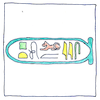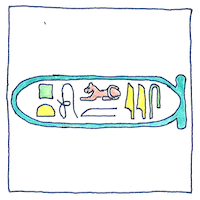Jean François Champollion
linguistics

|
Deciphering hieroglyphics
Christians who feared Egypt’s demonic past eradicated the hieroglyphic script before the end of the fourth century. Meanwhile, the Egyptian language evolved into Coptic, which had its own script called ‘Demotic.’ Arabic displaced all this in the eleventh century. For centuries, no one knew that hieroglyphics were both acrophonic and pictographic. People thought these glyphs were arcane symbols of pagan wisdom or devil worship. They didn’t know that Coptic was a direct descendant of Egyptian. Naturally, deciphering hieroglyphics stymied the best linguists. Even after the Rosetta stone was found in 1799, decipherment was futile until 1814 when Thomas Young guessed that each cartouche on the Rosetta stone was the name of someone important. The Rosetta stone gave the same text in Greek, Demotic, and hieroglyphics, including the names of Ptolemy and his queen, Berenika. Young knew that the Ptolemaic dynasty would have Greek names because the Ptolemaic dynasty were foreigners to Egypt, so he figured that the names of would be spelled phonetically. Young did a decent phonetic transcription of the names, assuming that they sounded like the Greek, ‘Ptolemaios,’ but too bad. He was still brainwashed, thinking that the hieroglyphs were pictographic, so he didn’t think that the other hieroglyphs should be interpreted like the names in the cartouches. The solution to this puzzle waited until 1822 when Jean-François Champollion having been obsessed with hieroglyphics since 1801 at the age of ten, having learned Coptic as a teenager, studying the liturgy of the Christian Coptic church, tried to interpret a cartouche that begins with a circle with a dot at its center. Thinking it should symbolize the sun, he used the sound value of the Coptic word for the sun, which is ‘ra,’ realized that this was the cartouche for the pharaoh Rameses, because that Rameses was the only pharoah whose name begins with this phoneme, realized that the Egyptian scribes spoke Coptic, and that all the other hieroglyphs could be interpreted phonetically, ran into his brother’s office yelling “I’ve got it” and then collapsed.
Cartouche
For the small square make the unvoiced bilabial ejective ‘P’ sound, the sound that begins the Egyptian word for a reed mat, such as the small mat that the Egyptian scribes knelt upon to work. For the upside-down semicircle under this, representing a loaf of bread, make the voiceless alveolar plosive ‘T’ sound. For the odd looping thing like a whip that follows, make the short ‘O’ vowel sound. My references don’t tell me what object this hieroglyph once represented. Next, the sitting lion signifies the same phoneme that starts the English word ‘Lion,’ so pronounce an ‘L’ followed by an ‘E’ vowel. Under the lion, we have another obscure hieroglyph for which you should produce the voiced bilabial nasal consonant ‘M.’ For the pair of flowering reeds pronounce the forward closed ‘I’ or ‘Y’ sound, and for the final image, the edge of a folded cloth, pronounce the unvoiced alveolar sibilant ‘S.’ All this enclosed in a rounded rectangular loop of rope with overlapping ends on the right called a ‘cartouche’ and pronounced, as a whole, ‘Ptolemys.’
Living systems
Ezra Pound studied Ernest Fenollosa’s notes on the Chinese written language and proclaimed All language is buried metaphor. The Chineses character for ‘dawn’ is the sun rising over the top of a tree. Our Roman letter ‘A’ derives from the Phoenician letter itself derived from the Egyptian hieroglyph of an ox head. Our verb ‘to be’ comes from the Sanskrit word ‘to breathe.’ Language is a game and not merely a game. Ultimately an idea is a thought and a thought is the digestion of a set of conditions and these conditions once affected our survival as much as breathing, or eating, or running after game.




Champollion was an incredible linguist. He knew Coptic by the age of 16. By the age of 20, “he could also speak Latin, Greek, Hebrew, Amharic, Sanskrit, Avestan, Pahlavi, Arabic, Syriac, Chaldean, Persian, and Ge'ez in addition to his native French.”
The fact that knowledge of the relation between Egyptian and Coptic was lost for centuries is an example of the destructiveness of religious bigotry, culturalism, and nationalism.
Egyptian hieroglyphics retain their occult, mystical, and magical connotations in Western culture. The Rosicrucians, for example, borrow Egyptian mysteries (as well as Greek and Druidic).
See also in The book of science:
Readings: